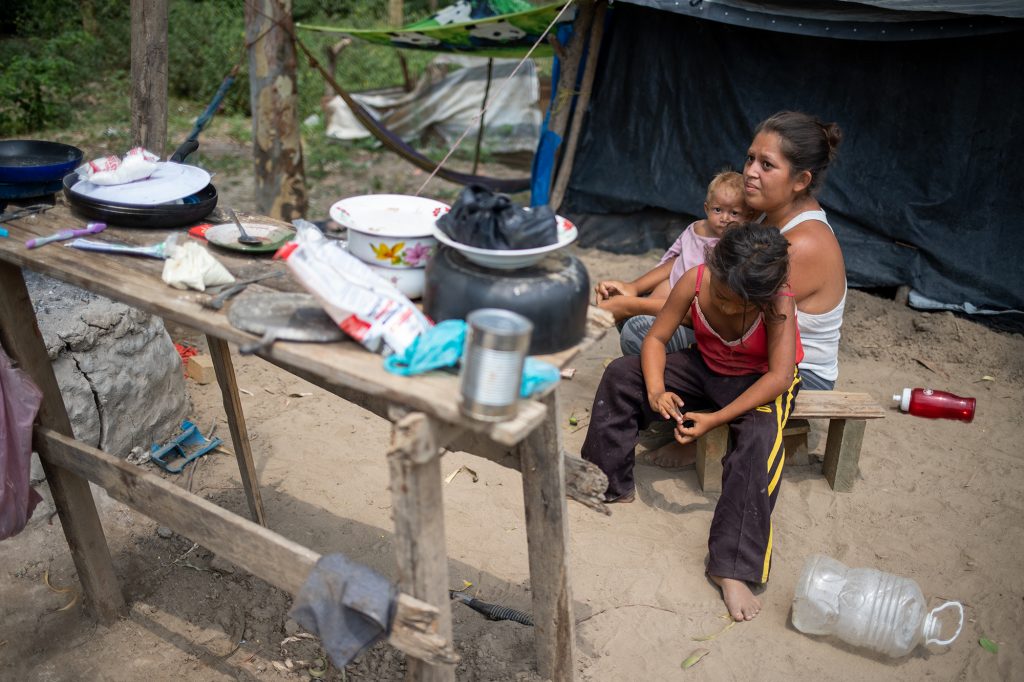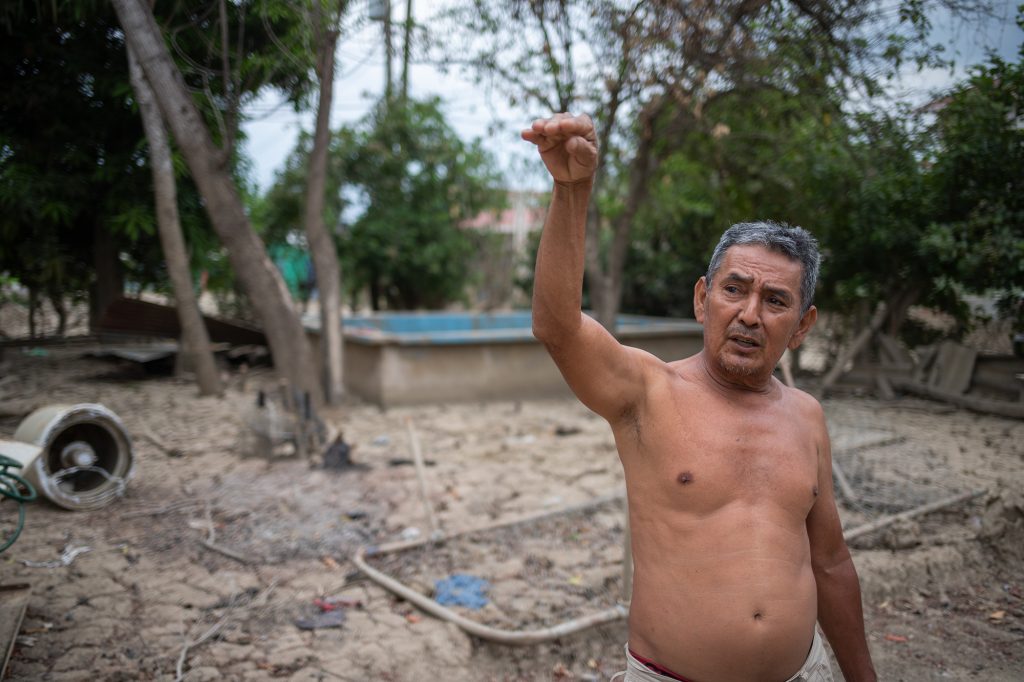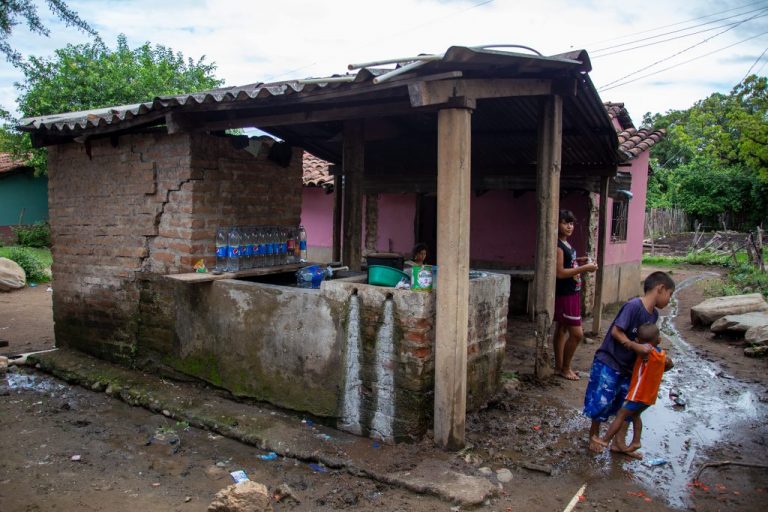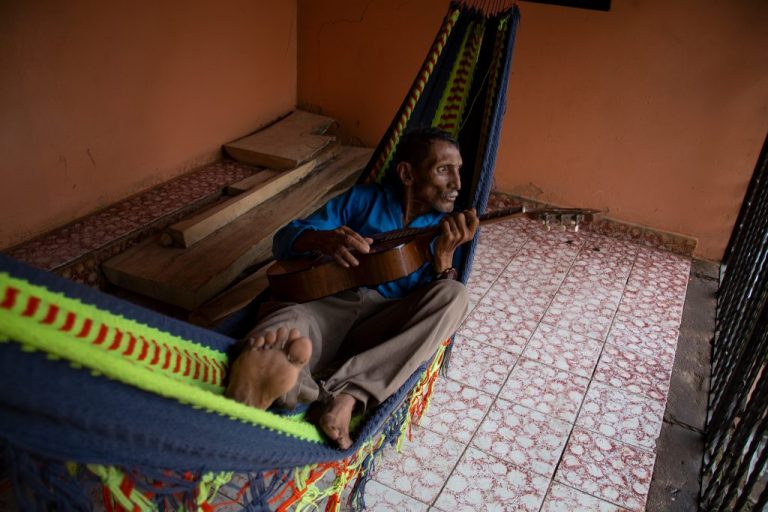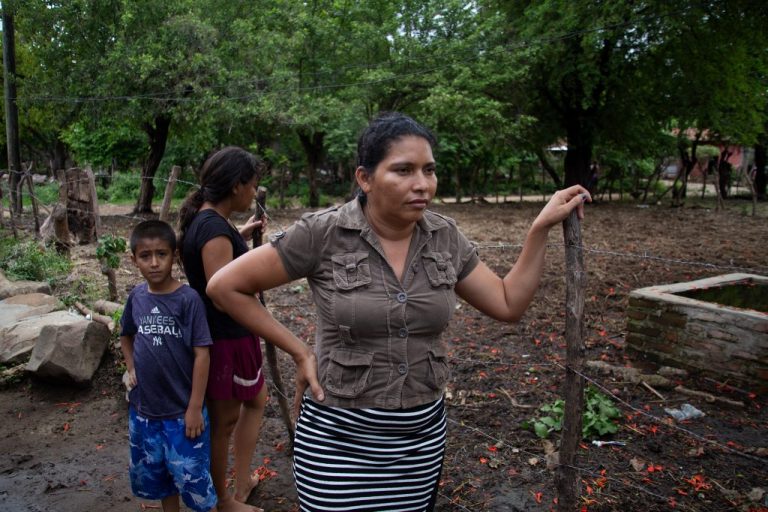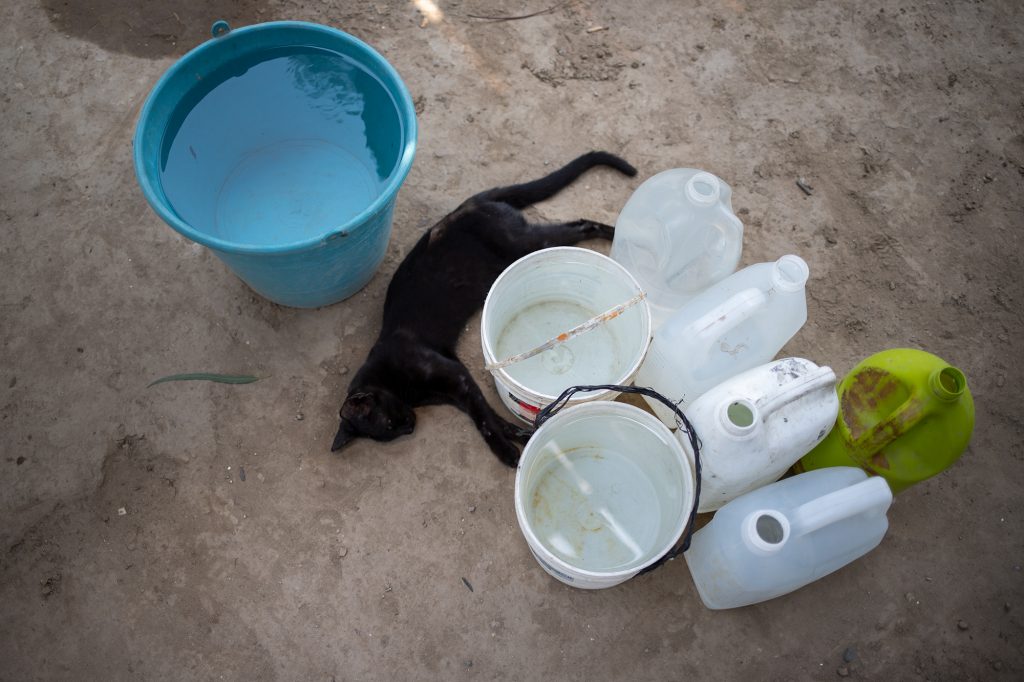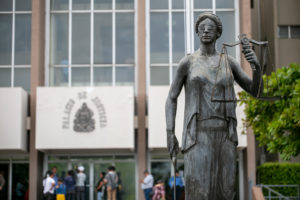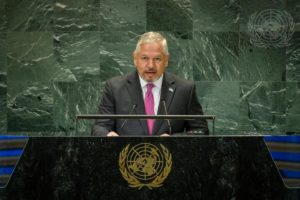Churches and NGOs are leading the way in helping victims recover from Eta and Iota in La Lima and the Chamelecón area. Six months after the disaster, the government’s You Are Not Alone program is not reaching all those who need assistance.
By Alan Bu
Photo by Martín Cálix
Less than a kilometer from the Chamelecón River, 63-year-old María Luz is hacking away with a machete. She is clearing brush a few meters from her house on the edge of the Canaán neighborhood in the Chamelecón area of San Pedro Sula. The river runs quietly and harmlessly past the neighborhood. But six months ago, swollen by rains from Hurricanes Eta and Iota, the river rampaged destructively through the Sula Valley.
Doña María lost her home when it was buried under tons of earth and sand left by the floods. She fled the raging waters of the Chamelecón River on November 5 and took refuge under the overpass of the highway to western Honduras. She lived there for three months and returned in February to the place where her home used to be. “I was living under that bridge for a long time,” she says.
The 2021 report issued by the Ministry of Development and Social Inclusion (Secretaría de Desarrollo e Inclusión Social – SEDIS) indicates that the storms affected 4.5 million Hondurans – almost half of the country’s population. The Economic Commission for Latin America and the Caribbean (ECLAC) estimated the economic losses from storm damage at US$1.8 billion.
The SEDIS report states that 100 Hondurans died from storm-related causes, 1,088,798 were evacuated from their homes, and 91,886 were relocated to temporary shelters. In addition, 341,901 Hondurans were stranded and isolated from services and support.
According to official government data, there were 190 landslides, 135 rivers overflowed, and 390 areas flooded during and after the storms. There was extensive damage to road infrastructure ⎼ 69 bridges were destroyed and 72 damaged. The most severe impact was to residential housing ⎼ 1,431 homes were totally destroyed, 6,165 damaged and 89,614 affected.
One of the destroyed homes belonged to Doña María Luz, who told us that she was tired of living under the overpass. So she returned to the banks of the dangerous Chamelecón River even though she had no home anymore. “I wanted to come back. I had a beautiful wooden house here, but the floods swept it away,” she said with a sigh.
In March, Doña María Luz received US$202 in financial assistance from the government. She bought some old zinc sheets for US$73 and built a small shack with her neighbors’ help. It now has a bed that her niece gave her and a few other donated items. “It gets hot in here around noon, so I strung up a little hammock over there,” she says, pointing to two trees where she had been clearing brush with her sharp machete.
During our reporting from the flood zones, only María Luz confirmed having received any government assistance. The government launched Operation You Are Not Alone soon after the November storms, which included a recovery and clean-up effort, temporary shelters for displaced flood victims, and the delivery of 60,000 “Better Life” packages. These packages included beds, stoves, water filters, propane gas tanks, cleaning kits, and groceries.
The government announced that SEDIS delivered 22,500 individual emergency payments to people living in the affected areas, primarily in the departments of Cortés, Yoro and Atlántida. As of February 2021, the government had disbursed a little over US$6 million in emergency payments. Each beneficiary received US$333 and SEDIS Minister Zoila Cruz promised to reach “every corner of the country.” Six months later, storm victims in Chamelecón and La Lima say they haven’t received any financial assistance. They probably never will.
***
In Chamelecón, many families are trying to resume the lives they had before Eta and Iota, but almost no one has been able to do so. They have only returned to their devastated neighborhoods because they had nowhere else to go. They went back to the place where the river swept away their homes and all their belongings last November.
As we walk along the banks of the Chamelecón River, we spot a man fishing in a small pool of stagnant water. As he pulls up his fishnet, a small boy who was watching says, “Hey, that’s a big one!” Will Nolasco has just caught a tilapia in a pool that had formed between the riverbank and Colonia Canaán.
He chats with us pleasantly, telling us that about two weeks ago he said to himself, “I bet there’s fish in there.” He was right ⎼ we watched him catch a one-pound fish. It was a bit muddy, but very much alive after being trapped in this pool when the floodwaters receded.
Will used to work in construction and did sheet metal work, but that all changed after the storm. His family left the area while he stayed behind. He says he helps neighbors rebuild their houses and gives them fish when he can.
Nolasco tells us that he fishes to pass the time and gives most of his catch away. “People here are very poor and there’s no work,” he says.
The mandatory pandemic lockdown decreed on March 14 last year led to the furloughs and layoffs of thousands of workers. Experts estimated that about half a million jobs would be lost due to the pandemic. But the consequences of the storms may push job losses up to 800,000.
In its 2020 annual report, the Central Bank of Honduras estimated that the gross domestic product contracted at least 9% due to the pandemic, which as of May 2021 had seen 218,330 coronavirus cases and 5,585 deaths, according to government data.
ECLAC reported that 57% of Hondurans lived in poverty during the pandemic. In 2020, Honduras’ external debt exceeded US$10 billion and the country acquired new debt obligations amounting to US$2.28 billion.
«ECLAC reported that in 2020, 57 % of the Honduran population lived in poverty.».
The future does not look promising for Hondurans, especially for Katherine and her family, whose home was swept away by the river. She made her escape at 8:00 pm on November 5 with her husband and their three daughters, and took refuge on the main highway to Tegucigalpa.
After living alongside the highway for a while, they returned to where their house used to stand, even though they had no water or electricity. They still don’t have these services. “The president of the neighborhood association says that since we live in a protected green area, we’re not going to get electricity or water service,” said the young mother.
Her family spent two months living on a highway sidewalk, but Katherine wanted to return to live by the river that took everything from them. “I couldn’t sleep next to that highway thinking that a truck could hit us. I told my husband that we should come here and make a little shelter out of tarpaulins,” she said.
So that’s where they live now, with uncertainty and precariousness. A piece of black plastic protects them from the elements. “When we first came back here, it was a disaster,” she says. The hurricanes pushed them even further into the depths of misery, and they haven’t been able to climb out.
Katherine’s husband works on a microbus, a rapidito as they are called here in Honduras. Their income is barely enough to survive. When they heard about the massive migrant caravans that were forming to go to the United States, they considered leaving the country. “We were thinking about it, but my husband thinks it’s too risky and said no,” said the young mother.
In December 2020, the Honduran government announced that it would invest US$101 million in new housing for storm victims. The announcement by SEDIS Minister Zoila Cruz indicated that 3,283 of the 5,133 planned homes would be located in the Sula Valley, costing an estimated US$44.3 million. None of these homes have been designated for the Chamelecón area yet.
Doña Maria Luz is one of Katherine’s neighbors, both in terms of proximity and the fragility of their lives. The misfortune of living in a country ravaged by its rulers and punished by nature’s fury brings them closer together.
The improvised stove that Doña María now uses was fashioned out of an old refrigerator that the waters of the Chamelecón River dumped near her house. She received some donated clothes and old kitchen utensils while she was living under the highway overpass. She enthusiastically shows us the heavy refrigerator that she found after the floods.
A niece gave her a bed and a church donated some food that she doesn’t recognize. “Look what they gave me. I don’t know what it is and they gave me three bags,” she says, smiling innocently as she showed us bags of lentils.
The elderly woman has three children but lives alone with her dog, Dutchess. “That dog won’t let anyone come near her,” she warns. While she was living under the overpass, her companion gave birth to nine puppies that she ended up selling for US$8 each. Dutchess helped Doña María make a little money in addition to providing some much-needed companionship.
Machete in hand, Doña María told us that she doesn’t depend on her children. Even though they help her, she doesn’t want to stop working. “They scrounge for a living and so do I. I’m not saying that they don’t help me out sometimes with a little money for bread and eggs, but it’s not much. I go out and collect cans and jars ⎼ that’s how I get by,” she tells us. “I love men’s work,” she says, adding that she also makes and mends clothes, although two of her sewing machines were lost in the floods.
La Lima ⎼ a city abandoned
La Lima was the epicenter of the Eta and Iota storm damage. Only a few houses were spared by the floodwaters of the Chamelecón River. In an interview with Contracorriente, Santiago Motiño, the mayor of La Lima, told us that this banana-growing municipality had suffered losses of more than US$1 billion.
Six months after the disaster, the banana capital’s downtown area looks like it’s back to normal, but storm damage is still very visible all over the city. The storms are not just a bad memory in the Filadelfia neighborhood ⎼ devastation is everywhere. We found huge piles of mud at the entrance to the neighborhood that had been scraped from streets and alleyways and dumped on what used to be a soccer field.
“They’ve already removed about that same amount,” says Don Cruz Guzmán, who came over to talk to us next to the mud pile. Even though it was very dusty when we were there, the streets were passable. But one local resident tells us, “Come when it’s raining and you’ll see. You can’t get in here.”
They have no potable water service and the sewage system was clogged by the floods. Some residents estimate that less than 40% of the families that used to live here have returned. There are many empty and filthy houses.
«In the Filadelfia neighborhood of La Lima, there are still no basic services and more than half of the families that used to live here have not returned to their homes».
Don Cruz returned home on March 28, almost five months after he left on November 3. Mud was everywhere when he returned, but he tells us that he “didn’t want to keep bouncing around anymore.” It took the government almost four months to start cleaning the streets. A backhoe sits idle next to mountains of mud. Neighbors say it’s been sitting there for four days.
The story is much the same in the Roma neighborhood next to Filadelfia. There are still traces of mud in the streets and many houses remain empty. “We all had to leave. It was an unexpected flood,” says Don Antonio Cruz Banegas, a 60-year-old local resident.
“There was a lot of mud here, and it took a long time to dry up enough so that we could get into the neighborhood. We’re adrift here, depending on God alone,” said Don Antonio, a bricklayer who’s had very little work in recent months.
He said that an Armed Forces contingent came to help clean out houses, but they didn’t bring enough cleaning equipment and it took a long time.
NGOs and churches step in for an absent government
“The financial assistance for families affected by the pandemic and hurricanes is not charity ⎼ it’s about social justice,” said President Juan Orlando Hernandez on social media.
The Honduran government announced that as of April 21, it had provided 22,500 families affected by the hurricanes with emergency financial assistance. The government intends to eventually provide this financial assistance to 60,000 families.
While the government’s official statement was widely disseminated by pro-government media outlets, most of the people living in the affected communities claim that they have not received any help from the government.
In the San Jorge neighborhood, better known as La Playita, Vilma tells us that any aid to the community “comes from the United States. No politician has come here to help us, only that church.”
What Vilma refers to as “that church” is actually an individual that everyone calls “the Gringo” because he’s from the United States. Although we were unable to find out much more about him, we heard that he is personally building 30 shacks for local residents who lost their homes in the floods.
All these wooden houses standing on tall wood pylons have now been built and will soon be habitable. The following foundations have also provided assistance in Chamelecón: Manos de Honduras, UNICEF, Mennonite Social Action Committee, and Habitat for Humanity. Two months ago, the World Food Program started food distributions and has handed out more than 2,000 food rations so far. The Cortés Chamber of Commerce and Feed the Children have also collaborated.
Vilma and two of her neighbors told us that they haven’t received any help from Mayor Armando Calidonio. “He came in early January to meet with us and told people to return to their homes because he didn’t have any money in the budget to get them out of the shelters. He signed us up to get zinc sheets, but we haven’t received them yet.”
«Calidonio came here in early January to meet with us and told people to return to their homes because he didn’t have any money in the budget to get them out of the shelters».
Despite what Calidonio told the flood victims, his municipal budget has almost doubled since he took office after former mayor Juan Carlos Zúniga. In 2019, the municipal budget was US$213 million, dropping to US$202 million in 2020. The COVID-19 pandemic led to another budget reduction in 2021 to US$178 million, about US$24 million less than the previous year.
Mayor Armando Calidonio has posted messages to social media informing the people of San Pedro Sula that from 2014-2020, US$321 million had been invested in public infrastructure projects. The municipality contributed US$252 million of this amount, while US$48.7 came from the 21st Century Public-Private Alliance (Alianza Pública Privada Siglo XXI), in which William Hall Micheletti, Yankel Rosenthal and Juan Sabillón are partners. The central government has invested US$28.5 million in the city.
But when he came to make his speech on the banks of the Chamelecon, Calidonio ⎼ who is seeking a third mayoral term ⎼ said he had no money for social assistance initiatives. Reducing the social gap is one of the unfulfilled promises of his administration, said councilwoman Fátima Mena in an interview with Contracorriente.
As she cradled her eight-month-old baby, Katherine told us pretty much the same story as Vilma. “Recently, maybe about three days ago, we were told that the mayor was going to send us some aid. So they signed us up, but we haven’t heard anything more about it,” she said. The social justice proclaimed by President Hernandez has not reached this little shack made of plastic and sticks.
Although the Honduran government should be in charge of providing assistance to disaster victims, Odalma Henríquez, the Red Cross coordinator for this region, told us that the government hasn’t been involved. “Let me tell you, the government finally started to do some cleanup about three months after the storms.”
Unfortunately, even in emergencies, politicians are always trying to get votes. “Really, the government has done very little. Since we’re in an election year, our political leaders are not being impartial. Everything is partisan politics and that’s sad,” said Henríquez.
Henríquez hopes that the painful experience of the November 2020 natural disaster will change the way people prepare for these disasters. “This has taught our communities to be prepared and to understand that ‘We are the first responders.’ That’s the lesson of Eta and Iota,” she says.
In La Lima, specifically in the Roma and Filadelfia neighborhoods, the situation is much the same. Sewer and potable water services have not yet been reestablished, “but supposedly, help is coming from Canada to fix this ⎼ they want to change the sewer system,” said Antonio Cruz. “Look, the truth is … we haven’t gotten anything from the government. Just a select few of their own people have been helped,” he claims. But he also admitted to receiving about US$250 in aid from a Canadian organization that he couldn’t identify.
Six months after Eta and Iota, the devastation is still tangible in Chamelecón, La Lima, El Progreso and everywhere else affected by the floods. Those who live there only get fed dribs and drabs of information, despite what the official government statements say.
Honduras, crippled by the pandemic and then devastated by two major storms, is still in the throes of a severe economic crisis exacerbated by government dysfunction. The memories of the natural disaster have not yet faded. Katherine is more vulnerable than ever in her plastic house, but she has nowhere else to go. “You get scared here when it starts raining, thinking that maybe it won’t stop and the river will rise again,” she said.




